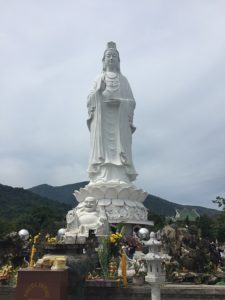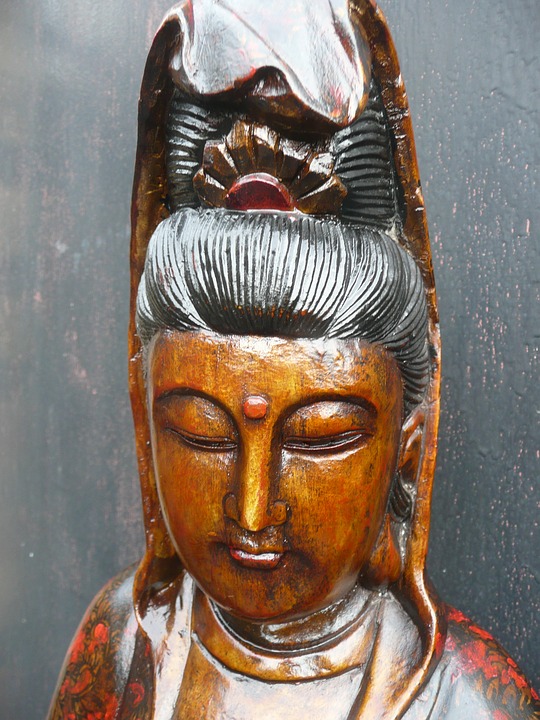Most commonly known as the Buddhist Bodhisattva of Infinite Compassion, Quan Yin became the perfect human being through the mantra (or prayer) Om Mani Padme Hum. She is a symbol of one woman’s sacrifice for mankind. Known by many names, the name Kuan Yin is short for the Chinese title Kuan Shih Yin, meaning “observing the sounds of the world” or “she who hearkens to the cries of the world.”
Kuan Yin is venerated universally across Asia. She is mentioned in the Book of Lie Zi as a Taoist Immortal. Catholics of the Philippines associate her with the Virgin Mary. Kuan Yin is also revered to by fishermen, who pray to her for a safe voyage ahead. Even though she is popularly depicted as a white-robed female holding a Lotus, she also takes the masculine form of Avalokitesvara, the manifestation of all the Buddha’s compassion.
Kuan Yin – A Version Story
There are several stories that claim to be the accurate legend of Kuan Yin. In one such story, Kuan Yin is depicted as Avalokitesvara, who vowed that he would not rest before he could free all humans from samsara, the cycle of death and rebirth. However, this task proved difficult and he could not save all humans. Attempting to aid all those in need, he became so overwhelmed that his head broke apart into eleven different pieces. Amitabha Buddha then gave him eleven heads who he could hear all the cries of the world. Now that he could hear and comprehend all these cries, he attempted to help all those in need once again. He ran into another problem, however, his two arms were not enough and broke apart. Amitabha Buddha came back and gave him more arms. Different stories claim different numbers of arms; for instance, Himalayans claim he was given eight arms while some claim he was given a thousand arms. This is why Avalokitesvara is often depicted with eight arms, each holding up the Dharma, “the way of the higher Truths.”
Kuan Yin – Another Story
Kuan Yin is depicted as the Miao Shan. Miao Shan is said to be the daughter of a very cruel man who ruled over Sumatra around 700 B.C.E. Her father wanted her to marry a rich but cold man. Wanting to escape marriage, she begged her father to take a vow of celibacy as a nun in the local temple. Her father agreed, but he coincided with the monks to give her strenuous work in an attempt to change her decision. Even though the monks gave her a tremendous amount of work, she was able to complete all her duties with the help of the animals in the temple, who aided her because she was so caring. 
Seeing that she could not be discouraged, her father became outraged and set the temple on fire. Reportedly, she extinguished the flames without burning herself. Her father feared her so greatly that he ordered her to be executed. When she died, had already earned her place among the enlightened and was granted passage to enter Nirvana. However, standing at the threshold of Nirvana, she turned back and looked upon Earth and saw all the suffering. She decided to remain at the threshold of Nirvana and help everyone else reach enlightenment before she went into Nirvana. In another version of this story, when Kuan Yin is being executed, a mystical tiger snatches her. She is taken to a hell-like place where the dead reside. When brought before the demons to receive punishment, she played music and flowers grew all around her, turning it into a heaven-like paradise.
Kuan Yin’s influence on Asian spirituality is as broad as the veneration of the Virgin Mary to Catholics.
All around south Louisiana, idols of the Virgin Mary are placed in homes or public squares just as common as Jesus himself. Kuan Yin is depicted in the same manner in reference to Buddhists. She is sometimes portrayed as a mother but is most often depicted standing or meditating next to the Buddha himself. At a time when Christianity was banned in Japan, secret Christian organizations venerated statues called Maria Kannon, which is the Virgin Mary disguised as Kuan Yin. Kuan Yin and the Virgin Mary have become synonymous among Christian Asians.
Belief in Kuan Yin is very important to sailors, women, merchants, children, and criminal suspects. She is the goddess of compassion, mercy, childbirth, healing, and even fertility. She offers comfort to those who have done wrong. Being free from pride and vengeance, Kuan Yin is hesitant to punish anyone. People who have done wrong have a chance to redeem themselves because she does not believe in punishment. Kuan Yin symbolizes the ideal woman of the East, slender and pure. Because Kuan Yin ascended as a virgin, she introduces a religious life of celibacy as an alternative option to marriage. Kuan Yin creates a paradox by being both a virgin goddess and the goddess of fertility. She aids women in infertility in order to produce a male child, which would improve their status as a woman, but also, she protects women from unhappy marriages and sexual assault through a life of celibacy in a convent. Kuan Yin is the ultimate symbol of love and sacrifice in Asian religions, bringing hope to all those in need.






